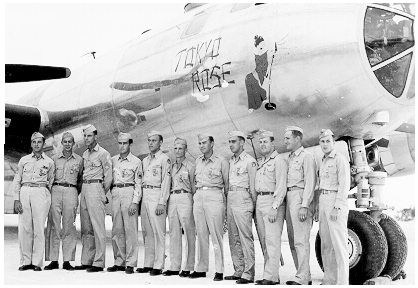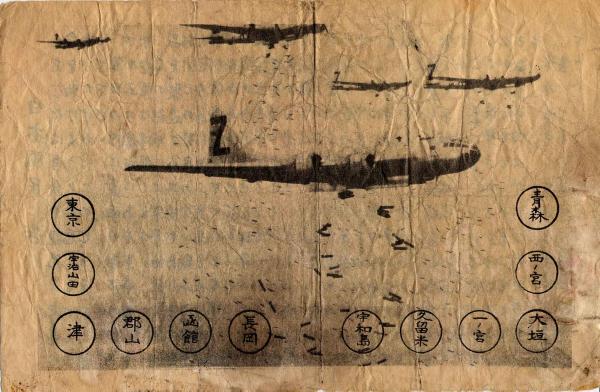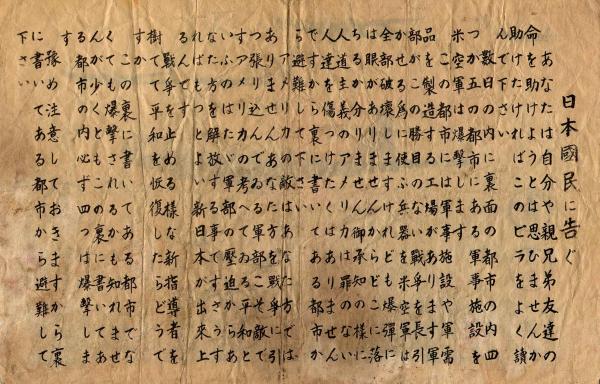My mother told me her memory that a B-29 flew over her home land, Hokkaido in summer 1945. It tailed a stream. Old Japanese pople remember B29 all over Japan. Newspapers wrote disasters of two nukes in Hiroshima and Nagasaki at once, though war press anouncement was not true at all. The US had to keep bombing by B-29s because they were productioned by a lot of US people's tax. FDR would be in trouble, if Japan surrendered at once after German surrender. Japanese leaders also wanted to continue the desperate war.
US Army decided to pay $85,652 for preapring a trial on 14 June 1940. USAAF decided to pay $3,600,000 for 2 trials on 29 August 1940. After checking a mockup, USAAF ordered 14 YB-29 and 250 B-29 on 19 May 1941. The first roll out was on 15 April 1943.
XB-29 made first flight on 21 September 1942. It had 22 fuel tanks with wing[6]. Ratio of weight to wing area was 10 times of light plane cub. Boeing began a test flight of YB-29 on 26 June 1943.
Source 2 : B-29, p11-14
FDR requested $300,000,000 for aircraft on 4 January 1939. US Congress approved purchase for 3,300 aircraft on 3 April 1939.
-
1941Jun16 order 14 YB-29 $1,403,623.86 AC19673
1941Sep06 order 250 B-29 $3,000,000,000 AC19673-1
1942Jan13 order 500 B-29 $5,300,000,000 AC19673-2
1942Sep19 total order 1,644 B-29
1944Mar-- production 100/month
1944Jul-- production 4/day
1946Jun10 last roll-out of 3,955th B-29
 |
Boeing B-29, p33
21st AF used a F-13 to take photos over Tokyo on Oct 13th 1944. LeMay writes that Japan will not intercept a single super fortress to keep forces against large scale raids. The F-13 took several thousand photos for 35 minutes over Tokyo. The F-13 was called Tokyo Rose.
B-29, p166
Remark : Translator of B-29, Watanabe points the right date, 1st Nov
Nickname
The Tokyo Rose invaded Tokyo at 9,800m altitude on a very clear day, Nov 1st 1944. Its height reached at 11,000m returning course.
Watanabe, p232
The nose art of Tokyo Rose was a woman of hair style like an onion who sweeps floor with a mop. She was not attractive like other painted women in B-29s. By the way I can imagine that a lot of people saw the exhausted stream. My mother told me that she saw streams of B-29 in summer in Hokkaido.
As matter of fact, Japan misjudged invading more than 3 aircraft from information on Nov 1st 1944. So Dinahs intercepted at full length. Tonys and Nicks of 18th, 144th, 53rd sentai did. Kitagawa says, 'I flew 11,400m high, but B-29 was flying over the altitude.'
Watanabe, p234
Precision bombardment
B-29s flew from Saipan and Guam to Japan mainland. Its flight took 13 or 14 hours. 94 B-29s flew Tokyo bombardment on 24 November for the first time. The first took off at 6:15 am. USAAF tried to destroy aircraft factories. A famous target, Nakajima's Musashino factory in the west of Tokyo which was called target #357. Though 20th AF bombered sevral times the target and B-29s could not destroy it, but Nakajima was forced to escape the factory and the production of Nakajima was very lowered. The factory stopped production on 30 April 1945. While B-29 bomed at #357 13 times. Only 10% of all the released bombs dropped within the area of the factory. 2% of them hit the buildings of target. USAAF lost 40 B-29s and 440 crews during the operation. The bombs killed 220 workers and hurted 266. The kill ratio was extremely bad for USAAF. It was natural US tax payers wanted much more kill ratio, considering US war history. How did Japan intercept B-29s on that day? A Ki-46 flew via Iwojima and photoreconed I Airfield of Saipan and North Airfield of Tinian on 6 November. On 9 November, A C6N photoreconed Guam.
-
10:30 IJN Irving and Judy patrol
11:00 IJA Ogasawara post sighted a lot of B-29s
11:05 IJN patrol boat sighted them
11:10 IJA 15th SQ and 70th Sentai actioned
11:30 IJA Full length action (53rd, 47th, 244th, 23rd, 70th etc)
11:58 IJN Alert over Yokosuka
| Date | Line | Place | KIA | Ref |
| Jun10 | Tokyu | Yokohama | All the passengers | Yokohama Kushu |
| Aug05 | Chuo | Yu-no-hana Tunnel | 52, 133 Wounded | I-no-hana Tunnel, Sagamihara rekishi |
| Aug08 | Nishitetsu | Tukushi Station | 64, 100 wounded at least | Tukushi Station |
Only P-51 invaded on 19 April. Only P-51 flew 730 sorties for 9 times from 26 April to 13 June. They loaded a drop fuel tank of 625L. 26 P-51s were lost.[9] P-51s raided trains. The table shows a few cases.
Escalation of tactics
| Range | Aircraft |
| 3,250km | B-29 with 5.5t |
| 1,500km | P-51 combat 30min |
| 1,200km | B-24 with 2.8t B-25 with 0.9t P-38 combat 15min |
| 800km | conventional single engined fighter combat 30min |
Watanabe, midasi
Superfortress B-29, p278
Todofuken-chou syozaichi
USN carriers aircraft burned engine assembly of the factory on 17th Feb 1945, though B-29 had tried 6 times already. While COA recommended targets of bombardment,
-
Prime aircraft factories
Fire bombs cities bombardment
Mine release siege
Kerr, p119
Japan tried to attack B-29s in airfields of Mariana 5 times.
IJA and IJN aircraft destroyed 24 B-29s and damaged 43 on Xmas.
Superfortress, p.179-180
Although daily precision bombardment did not have much effect, Night raid of B-29s was very effective to destroy civilian life of Japan, because they could carry bombs heavier than usual. The civilians had always had to sleep wearing usual working clothes for fear of night raids. The table compares 2 ways of bombing. 6 big cities of Tokyo, Nagoya, Kobe, Osaka and Yokohama were burned by B-29 till 15 Jun 1945. Japanese students in cities knew Japanese military propaganda by their teachers, newspapers and radio. Government decided to labor students for a year on 18 March 1945[2]. All the students in Japan began laboring for food and military production on April 1945.
Kerr p.82-83
Watanabe p.58-59
Morimoto, p257
| Date | Relased bombs | Release height ft | Returned time | Tactics | Target | Loss ratio |
| 44Nov24 | 5,000lb(2.27t) | 27,000-33,000 | night | formation | factory | 8.3% |
| 45Mar10 | 6.6t | 5,000-8,000 | noon | single | houses | 5.0% |
Announced bombardment result
21AF began to release airborne leaflet propaganda to inform bombing on July 28th. I think it was a triumph over Japan's sky war. I calculated loss ratio from 1st Aug to 8th Aug as follows. Certainly B-29s released not ordinary bombs but fire bombs over all the listed cities. Population ranking of Japanese cities is nowdays. A B-29 burned about 70 houses, when it bomberded at a small city.
B-29, p.59
Dai Toua Sensou kaisi irai ippan Kusyu higai no gaikyou
Nihon Hondo Kusyu
1945.8.2 4-shi kushu
| Date | Target (latitude, meridian) | Population ranking | B-29s released bombs | B-29 loss ratio | Burned houses | Houses /aircraft |
| Aug1 | Hachioji(35.67, 139.32) | 24 | 169 | 0.6% | 13,338 | 78.9 |
| Aug1 | Toyama(36.7, 137.22) | 41 | 173 | 0.0% | 11,986 | 69.2 |
| Aug1 | Mito(36.4, 140.6) | 87 | 160 | 0.0% | 10,104 | 63.2 |
| Aug5 | Nishinomiya | 31 | 250 | 0.4% | - | - |
| Aug5 | Maebashi | 68 | 92 | 0.0% | - | - |
| Aug8 | Fukuyama | 36 | 91 | 0.0% | 10,179 | 111.9 |
-
1st Aug
Toyama is on the coast of the Japan Sea. Hachiouji is the west of Tokyo. Mito is the north east of Tokyo and an IJA air base. Although the population of Mito was small, Mito seemed a depo of the coast positions.
Toyama : 2,700 killed, 8,000 wounded
Hachiouji : 500 killed, 2,000 wounded
Mito : 300 killed, 1,293 wounded
5th Aug
Targets of Maebashi raid were a Riken factory, a Nakajima factory and IJA airfield. Nishinomiya raid was to burn the city.
Maebashi Kusyu
Hanshin Dai-kusyu
8th Aug
It seems targets of Fukuyama raid were a Nihon Kayaku factory, Mitsubishi aircraft factory, a Teikoku Senryou factory, 41st infantry regiment HQ, IJN Kokutai. 354 killed, 864 hurted, 10,179 burned houses, 47,326 people suffered damage(81% of Fukuyama City). Tokyo big raid burned 267,171 houses or buildings[7].
Fukuyama Dai-kusyu
IJAAF stopped aircraft being in the end of Jun 1945. IJAAF decided to intercept B-29s at night. All the 10th, 11th, and 12th AW of working fighters were 250. Other sentai were, 30th FG(47th, 244th, 51st, 52nd sentai)
1st AF(1st, 11th sentai)
6h AF(101st, 103rd sentai)
20th FG(111th, 112th sentai)
Akeno, Hitachi
IJAAF had working about 450 fighters on July. the 1/3 of them seemed to be able to attack B-29s at night. But radars were preparing in local cities. Search lights were short. AI radars had not been practical yet. A night fighter could not counter single engine fighter naturally. So Japanese night fighters had to escape attacks of more than 100 P-51s from Iwojima almost everyday, and 300 to 1500 aircraft of USN attacked airfields at daytime. And worse telephones were not available among head quaters of air wings. I think it important the telephone network was incredibally poor in 1940s. Chihaya, an IJN officer had to wait 2 or 3 hours to call Tokyo office of IJN from Nagasaki office by phone in 1941. I think phone is a fatal bottle neck of IJN and IJA. After the Pacific War, GHQ was surprised at low quality of Japanese phone network. GHQ had to work to improve the network by themselves. Japanese phone network was poor because of simple electric part defects which were ceramic capacitors in amplifiers[1].
Chihaya p.78
If search lights were enough in big cities, pair of a radar and a search light could track a B-29 like UK method, though direction radars could not detect the flying height. For example, a pair of 2 IJA aircraft of 53rd sentai flew over Maebashi at 8pm with an radar information from Hachijyojima at 6pm. With a few search light, Nakagaki and Iimura pilot could not catch up a B-29. They returned Fujigaya at a loss for 20 minutes patrol. It was diffcult for them to fly 100km Maebashi and return at night. If IJA have well trained 2-seated night fighter like old Ki-45 with PPI radar enough, IJA could have shoot down a few of B-29s. And B-29s had to be equipped with machine guns againt IJA night fighters.
After all, Sei-go operation did not action. IJA explained aircraft being for Ketsu-go operation. Simply IJA could not intercept B-29s at night at all. Fukuyma burned 2 folds of efficiency compared with Mito. How easily did Fukuyama burn?
Watanabe p.269-271

|  |
| Inside | Outside |
| Target (latitude, longitude) | Population ranking |
| Hachioji(35.67, 139.32) | 24 |
| Nishinomiya(34.73, 135.33) | 31 |
| Fukuyama(34.48, 133.37) | 36 |
| Toyama(36.7, 137.22) | 41 |
| Nagano(36.63, 138.18) | 49 |
| Koriyama(37.40, 140.23) | 63 |
| Otsu(35.00, 135.87) | 65 |
| Maebashi(36.38, 139.07) | 68 |
| Kurume(35.32, 130.52) | 71 |
| Mito(36.4, 140.6) | 87 |
| Takaoka(36.75, 137.17) | below 125 |
| Maizuru(35.47, 135.38) | below 125 |
20th USAAF began to release leaflets on 28 July 1945. Lemay wrote that B-29s released some kinds of leaflet suggesting to flee from fire bombs after the big Tokyo raid on 5 March 1945.
Distance on the Earth
List of Japanese cities by population
Fukuyama
Hachiouji(35.67, 139.32)
Koriyama
Kurume
Maebashi(36.38, 139.07)
Maizuru(35.47, 135.38)
Mito
Nagano(36.63, 138.18)
Nishinomiya
Takaoka(36.75, 137.02)
Toyama(36.7, 137.22)
Watanabe p.407
Super fortress B-29, p207
Airborne leaflet propaganda
Beigun dentan
Tai Beiei Sinri-sakusen
Dentan
On air, US had released other leaflets to propagate VOA from Saipan using middle wave on 23rd Apr 1945.
But Nam War troubled US like a few northern nations and Japan troubled old China. Japan invaded China like traditional barbarians and pirates from the north and the sea in 20th century. I find peak-out of US power at the Nam War judging from ASEAN's diplomatic policy. Small nations always have watched powers.
435 B-29s displayed air power over the Tokyo Bay, when Japan surrendered on 2 September 1945. Soon US and Russia were competitve with nukes each other. US also had to fight new wars against China in Korea and Nam twice, as Japan worried about China in Korea and Manchuria before.
PB4Y-1
The USAAF agreed to turn over a batch of B-24 Liberators to the USN, which designated them PB4Y-1s. Ther first of these saw combat with Marine reconnaissance squadron VMD-254 which was sent to Espiritu Santo in October 1942. Other Marine photo-reconnaissance units which saw action with PB4Y-1 were, VMD-154 in January 1943, and VMD-354 a year later. Photo-reconnaissance flights were done at about 22,000ft (6705m).
Dorr, p43, p47
PB4Y-1P
In late April 1943, the Navy's first photographic squadron equipped with B-24s arrived on Espiritu Santo. VD-1 immediately began photographic patrols throughouth the Solomons. The full name of this type of squadron was Fleet Air Photographic Reconnaissance Squadron, which was shortend to VD. The squadron was formed in the spring of 1942 and was equipped with B-24. B-24 aircraft assigned to such squadron were designated PB4Y-1P which were equipped with two 400 gallon fuel tanks in the forward bomb bays, and one of the two rear bays was equipped with 4 mapping cameras, while remainning bay could carry bombs.
Carey ge, p15
USN converted 65 Liberators for photo duty and established four squadrons — VD-1 (January 1943), VD-3 (February 1943), VD-4 (August 1943) and VD-5 (July 1944). I think USN needed reconnaissance to plan invasion and a lot of maps for amphibious operation. I understood how often USN did photo-reconnaissance missions for Iceberg Operation in Okinawa. USN organized three squadrons and prepared invasion in 1943. While IJN built air bases in the Marshall Islands.
Dorr, p44
B-17
| Layer | Material | Thick |
| No1 | Neoprene | 0.5mm |
| No2 | Natural rubber | 2mm |
| No3 | Rubber cloth | 0.5mm |
| No4 | Vulcanized rubber | 0.5mm |
| No5 | Sponge rubber | 4mm |
| No6 | Leather | 2mm |
| No7 | Alminum | 3mm |
Ikari, p147
Toyou bakugeki
B-17s were diffcult to shoot down. Zero almost shot enemies by 20mm guns except for B-17. The shells could not penetrate armor behind B-17 cockpit. While Betty was fragile for enemy fighters' 13mm shells. Crews of Betty called the aircraft type 1 lighter. By the way, Betty was not installed armor plates till 1943.
Genda, p238
AEW
VB-116 began ECM (Electronic Counter Measures) missions in March 1944, flying PB4Y-1 Liberators modified with installation of the AN/ARC-1 radar intercept receiver ‐ similiar to the US Army's SCR-587. The squadron three-ship sorties against Japanese radars on Truk.
Dorr, p44
USN planned B-17 as AEW operation. The designation was PB-1W.
PB-1W
Watanabe wrote that Japanese governers always favored in US and had no concern with national sentiment except his election voters. I think Japan is the same as Philippines. Governers of Philippines awarded US army commanders who killed and punished revolted people. Recently my family watched on DVD of the Addams Family. My son understood the irony of relationship between native Americans and white pioneers or invaders. A white girl wanted to civilize a native American girl in a short drama. Revolted children had to watch on video of Disney. I remembered collecting seals of Disney's charcters in chocolate package[24] when a boy. Our generation absorbed in American pop culture. While Chinese goverment banned abroad animation for kids on 1 September 2006[27]. Chinese kids cannot watch Crayon Shin-chan any more on TV program.
 |
The Kanto army held a press meeting in Harbin Secret Military Agency on Aug 11. Asaoka showed a recorded film used a new weapon in China. The screen showed a Ki-48 loading something like a milk pan and 15 or 20 small ones.[11] The bomber took off. And The screen showed a field. The bomber released white vessels. It returned, some medics sprayed inner of the bomber. Asaoka said,'This film was made by an epidemic prevention department in Harbin. We made a trial of bio weapon in the middle of China.
Morimura p.166-p.182
The photo shows replica of IJA biowarfare bomb. The principle was developed Unit 731 in Manchuria. Although Japan could not develop nuclear bomb, Biowarfare weapon was developed by notorious 731 Unit of IJA in Manchuria. The bio weapon might hurt civilians as well as nuke, but it did not work as well IJA expected. It could not replace for usual explosive bombs. I don't know when the US knew 731 Unit. When IJA used chemical weapon in China, the US warned Japanese govenment the usage. Tojo stopped it for fearing US Army usage.
[1] Tokyo shijyo no kaitaku to eigyo-sho kaisetsu
[2] Kessen Kyoiku sochi-youkou
[3] Watanabe, p242-248
[4] Watanabe, p426
[5] B-29, B-29 shutsugeki list
[6] Super fortress, p.64
[7] Kerr, p192
[8] 核兵器の不拡散に関する条約 全文
[9] Watanabe, p378
[11] Ki-48
[21] Super fortress B-29, p178
[22] Super fortress B-29, p176
[23] Super fortress B-29, p302
[24] Marble chocolate
[27] 日本文化 no 影響
[29] ( 勲一等旭日大綬章 )

aboutMe
© 2007-2011 Enoki Sensor All Rights Reserved